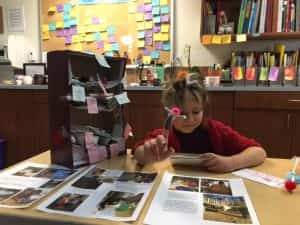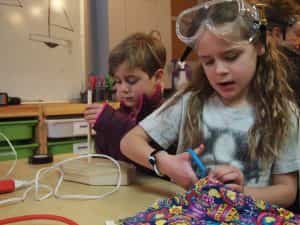by Alice Shi Kembel(proud mother of three boys currently attending Mackintosh Academy’s Boulder Campus)
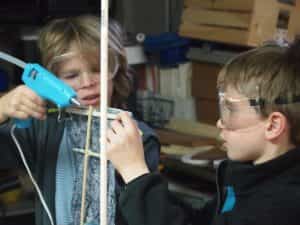 Our house is filled with trash. Not because I’m a terrible housekeeper, not because my husband shirks his weekly duty of taking out the trash, but because my children love making projects out of garbage, recycling, and anything else they find interesting. Anyone visiting our house would see any number of creations made by our three boys: bats with five-foot wingspans made of paper and masking tape, daggers whittled from sticks, Star Wars ships made of cardboard, guns created from anything and everything, bug zoos designed with wine corks and popsicle sticks, night vision goggles consisting of toilet paper tubes and duct tape, rocket ships constructed from boxes, snake traps, paper airplanes, mouse mazes, robots, and a two-pronged lice comb that my oldest son made for his kindergarten teacher out of wooden skewers and Scotch tape. While I haven’t fully embraced the effect all of this creativity has on the appearance of our home, my husband and I encourage this type of play, because we believe that allowing our children this freedom nurtures in them a spirit of innovation.
Our house is filled with trash. Not because I’m a terrible housekeeper, not because my husband shirks his weekly duty of taking out the trash, but because my children love making projects out of garbage, recycling, and anything else they find interesting. Anyone visiting our house would see any number of creations made by our three boys: bats with five-foot wingspans made of paper and masking tape, daggers whittled from sticks, Star Wars ships made of cardboard, guns created from anything and everything, bug zoos designed with wine corks and popsicle sticks, night vision goggles consisting of toilet paper tubes and duct tape, rocket ships constructed from boxes, snake traps, paper airplanes, mouse mazes, robots, and a two-pronged lice comb that my oldest son made for his kindergarten teacher out of wooden skewers and Scotch tape. While I haven’t fully embraced the effect all of this creativity has on the appearance of our home, my husband and I encourage this type of play, because we believe that allowing our children this freedom nurtures in them a spirit of innovation.
While some parents would likely shudder at the freedom we allow our children, we believe that teaching them a mindset of innovation will help them develop important skills that will benefit them as thinkers, learners, and community members. Furthermore, the ability to think innovatively will be crucial for them as they enter the workforce of a rapidly-changing world that faces complex challenges in the areas of technology, health care, the environment, and the global economy.
How do we nurture a spirit of innovation in children? Here are five principles you can start with:
Provide materials that foster creativity.
When my five-year-old wanted a Star Wars clone trooper mask, rather buy one for forty dollars, my husband cut up a plastic milk jug, drew on it with Sharpie, and attached a cord to the back. Our son was just as happy with his milk jug mask as he would have been with a commercial one, and seeing his father create his idea, simply with materials around the house, unlocked a new realm of possibility for him.
Give children access to a variety of materials that can be used in many different ways, and model for them 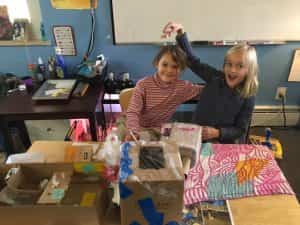 that their ideas can be made with these rough materials. Children can create from unexpected materials – paper, tape, sticks, toilet paper tubes, popsicle sticks, boxes, corks, egg cartons, leaves, rocks, and much more. Rather than buy toys for your children that have a singular, set purpose, choose toys that encourage creativity in their open-endedness. Examples include: Legos (without the instructions), Citiblocks, Tinker Toys, Magnatiles, straws and connectors, and blocks.
that their ideas can be made with these rough materials. Children can create from unexpected materials – paper, tape, sticks, toilet paper tubes, popsicle sticks, boxes, corks, egg cartons, leaves, rocks, and much more. Rather than buy toys for your children that have a singular, set purpose, choose toys that encourage creativity in their open-endedness. Examples include: Legos (without the instructions), Citiblocks, Tinker Toys, Magnatiles, straws and connectors, and blocks.
This process can work in reverse as well. Children can be inspired to create a project from what they find compelling about various materials. My boys, after they had collected numerous toilet paper tubes, created several sets of night vision goggles and binoculars because the cylindrical nature of the tubes triggered their imaginations in that direction. Materials that foster creativity can give form to the ideas that children already have, as well as spark novel ideas in their imaginations.
Emphasize that there is no right way to create something.
When my oldest son was a toddler, in a never-ending quest to keep him occupied and out of mischief, I found a painting activity in a book that I thought he would enjoy. After spending twenty minutes setting up the activity, I presented the materials to him and said, “Look, you can use these paints on the sliding glass door and then wash them off with the hose!” He performed the intended task for about three minutes, and then proceeded to experiment with mixing paint colors for the next twenty. As a rule-following, structured person, I was tempted to tell him that he wasn’t using the paint the “right” way; I had, after all, invested twenty minutes of my time to create the experience that the book described. Instead, I refrained from saying anything and followed his lead, and his paint mixing experiment ended up being far more intriguing for both of us.
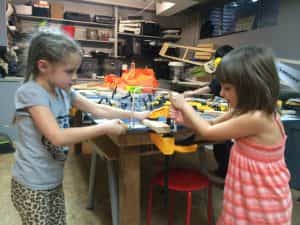 As adults, we often take a “teacher-learner” approach with children; we teach, they learn, and we tell them when they’re doing something right or wrong. When it comes to innovation, use a “learner-learner” approach. Resist the urge to instruct your child in the “right” way to do something; allow them to experiment on their own. Children can often surprise us with the unique ways that they utilize materials to design what they imagine. They may incorporate a material in an unexpected, novel way, or use a completely different process to create their ideas. Instead of saying, “You should do it this way,” or, “That’s not going to work,” use neutral language that encourages independent thinking, such as, “That’s interesting, I wonder what else we could do with that,” or, “I wonder how that’s going to work.” Give your child the opportunity to think for himself without the idea that there is a “right” or “wrong” when it comes to innovating, and both of you will likely learn from the process.
As adults, we often take a “teacher-learner” approach with children; we teach, they learn, and we tell them when they’re doing something right or wrong. When it comes to innovation, use a “learner-learner” approach. Resist the urge to instruct your child in the “right” way to do something; allow them to experiment on their own. Children can often surprise us with the unique ways that they utilize materials to design what they imagine. They may incorporate a material in an unexpected, novel way, or use a completely different process to create their ideas. Instead of saying, “You should do it this way,” or, “That’s not going to work,” use neutral language that encourages independent thinking, such as, “That’s interesting, I wonder what else we could do with that,” or, “I wonder how that’s going to work.” Give your child the opportunity to think for himself without the idea that there is a “right” or “wrong” when it comes to innovating, and both of you will likely learn from the process.
Provide scaffolding for children in their creative processes.
When my youngest son was two, he wasn’t able to rip off pieces of tape by himself, but he wanted to use tape for his projects. Instead of doing it for him, I started off by tearing off the tape pieces for him while allowing him to stick the tape on by himself wherever he wanted. When he was a little older, I held the tape dispenser for him, had him pull out the end of the tape to the length he wanted, and helped him tear off the pieces. When he was even older, I placed my hands over his and showed him how to hold the tape dispenser with one hand, pull the tape with the other, and tear it off by pulling it slightly downward against the blade.
This approach is often called “scaffolding.” Once children have an idea in mind of something they  want to create, resist the urge to tell them how to do it, even if they ask. Instead, give them just enough assistance to help them progress, while still fostering their independence. The concept stems from psychologist Lev Vygotsky’s theory of cognitive development, which states that help from adults is most beneficial when it is provided in the Zone of Proximal Development, just above the level of what a child can achieve on his or her own. Scaffolding allows children to accomplish more than they could by themselves in a developing skill or ability, and enhances the learning process. Scaffolding techniques might include breaking a process down into simpler steps, providing hand over hand assistance, or giving feedback as the child works on a project. As children develop and learn, their Zone of Proximal Development changes constantly, so parents need to adjust the level and type of assistance they provide to optimize the child’s learning and increase independence.
want to create, resist the urge to tell them how to do it, even if they ask. Instead, give them just enough assistance to help them progress, while still fostering their independence. The concept stems from psychologist Lev Vygotsky’s theory of cognitive development, which states that help from adults is most beneficial when it is provided in the Zone of Proximal Development, just above the level of what a child can achieve on his or her own. Scaffolding allows children to accomplish more than they could by themselves in a developing skill or ability, and enhances the learning process. Scaffolding techniques might include breaking a process down into simpler steps, providing hand over hand assistance, or giving feedback as the child works on a project. As children develop and learn, their Zone of Proximal Development changes constantly, so parents need to adjust the level and type of assistance they provide to optimize the child’s learning and increase independence.
Teach children to view setbacks as opportunities to learn rather than as failures, and encourage them to embrace an attitude of experimentation.
When my oldest son was five, we received a box of Magnatiles as a gift. My son immediately began building a tower with them. At a certain point, the structural integrity of the tower failed, and it collapsed with a resounding crash. My son dissolved into tears. My immediate inclination was to rush to his side, comfort him, and reassure him that we could build the tower again. To my surprise, my husband said, “Wow, that was interesting! Did you see how that collapsed?”
My son stopped sobbing for a moment, intrigued.
“I noticed that this part seemed weak,” continued my husband. “What do you think we could do to make it stronger?”
My son’s crying ceased completely as he began to contemplate the remnants of his tower and the pile of Magnatiles in front of him. “Well, maybe we need some supports instead of building it straight up,” he said.
“Let’s give it a try and see what happens. Do you have an idea for what kind of supports you want to try?”
They began rebuilding the tower, making modifications as they went, and quickly finished a sturdier structure.
“See, buddy, even though it can be frustrating when something doesn’t work, it actually helps us learn so that next time we can make it even better!” said my husband.
“Yeah,” said my son. “Now my tower is really strong!”
After experiencing more of these incidents, with my husband coaching him, our oldest began seeing falling towers and broken Lego ships as opportunities for improvement rather than as indicators that he was doing something wrong. He has developed such resilience from this mindset that his frustration tolerance has increased tremendously, and he has a much greater capacity to persevere on his projects.
When a project falls apart, gets knocked down, breaks, or is in some way unsatisfactory to a child, model a positive view of setbacks by encouraging children to think about what they can learn from it. Some children, particularly those with a low frustration tolerance or who are perfectionistic, will be upset when something goes wrong. Acknowledge their feelings and then ask questions such as, “That’s interesting, what happened there? What can we learn from that? What can we try next? How can we change what we’re doing to make it better?” When parents point out that children can make their projects even better when things don’t go as planned because they can learn something in the process, children will be more likely to accept setbacks as learning tools rather than view them as barriers that paralyze their progress.
In addition, encourage children to experiment with their ideas and make quick representations of them rather than focus on a finished product. Most children incorporate this attitude naturally in their play as they explore and try new things, but can be overly concerned about producing a perfect end product when attempting to create something. As parents, we can help establish a culture of experimentation by prompting them with questions and comments that emphasize learning and problem-solving. “That’s interesting, what do you think? What can we try really quickly to test out this idea? What can we try next to help us learn? What if we sketch this out to see what might work?” are examples of questions that remove the pressure of making something perfect from the start and bias children towards action. For example, if a child is frustrated that his drawing is not turning out the way he wants it to, we can ask, “Can we just do a quick one first before we do the real one? We might learn something from doing a sketch that might help us go forward.” This approach helps children test their thinking and identify and resolve problems early on, reducing the need for perfectionism and instilling confidence in their own creative abilities.
Praise the effort children put forth in the creative process, not their innate abilities.
My oldest son recently went to a birthday party. When I asked him what kind of cake was served at the party, he said, “We had red velvet cupcakes. They were really good, Mama. They were way better than yours. You need to try your hardest next time you make them.”
Instead of feeling offended, I laughed, as it was obvious that the intentional ways my husband and I had been praising our children had rubbed off. Rather than telling our children that they are smart or creative, we are constantly pointing out what they are able to do independently, how we see them giving form to their ideas, and what we see them learning in the process. We have chosen to encourage them this way because research suggests that praising children’s innate abilities may do more harm than good, and that they benefit more from having their efforts praised, rather than their ability. Psychologist Carol Dweck has discovered that praising children’s efforts yields motivation and resilience in learning, even in the face of challenges. Focusing on effort means that children perceive themselves as being in control of their successes, whereas emphasizing intelligence means that success or failure is not within their control.
Rather than tell your children that they are creative or artistic or smart when they are engaging in the creative process, praise them for working hard, experimenting with new strategies, and persevering through difficulties. Dweck calls this type of praise effort or “process” praise, and here are some examples:
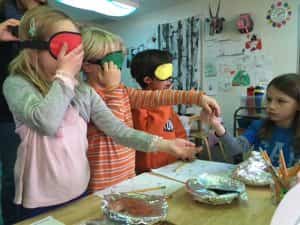 “You worked really hard on your paper airplanes, and it shows. You tried a few different ways of folding it, made the changes you wanted, and now you have something that flies the way you want!”
“You worked really hard on your paper airplanes, and it shows. You tried a few different ways of folding it, made the changes you wanted, and now you have something that flies the way you want!”
“You were frustrated that your Lego ship kept breaking apart, but you didn’t give up. You changed the parts that were fragile, and now your ship is stronger because you kept working on it. That’s great!”
“I like the way you used so many different materials to make your puppet. It looks like it took a lot of work, but you learned how to make different materials stick on the popsicle stick, and it makes it look so colorful.”
By praising children’s creative efforts rather than labeling them as “creative,” they are empowered and motivated to innovate without fear of failure, and view themselves as continuous learners.
These principles for nurturing creativity in children are highly intertwined and interchangeable. When we provide materials for children to work with freely, without telling them the “right” way to use them, they are free to experiment and develop their own ideas. When we provide scaffolding rather than impose a particular plan on the process, they learn from and become more accepting of their setbacks. When they are able to view setbacks as learning opportunities, they become more willing to work with an attitude of experimentation, and confidence in their own creative abilities increases. When we praise children for their efforts rather than their abilities, they are more resilient in the face of difficulties, and see themselves as constant learners.
Incorporating these concepts can foster a spirit of innovation in your children; they will experience freedom to work in a way that is true to who they are, because safety has been established for their creative processes. This approach can also help them develop resilience, problem solving skills, confidence, flexible thinking, curiosity, intrinsic motivation, persistence, and the ability to question assumptions. What’s more, children discover a joy in the process, a richness and vitality from risk-taking that instills in them a love for learning.
As a parent, what I appreciate the most about nurturing a spirit of innovation in my children is that it creates space for their unique voices to shine, and honors what is special about each of them, and I can’t wait to see what they’ll design next.